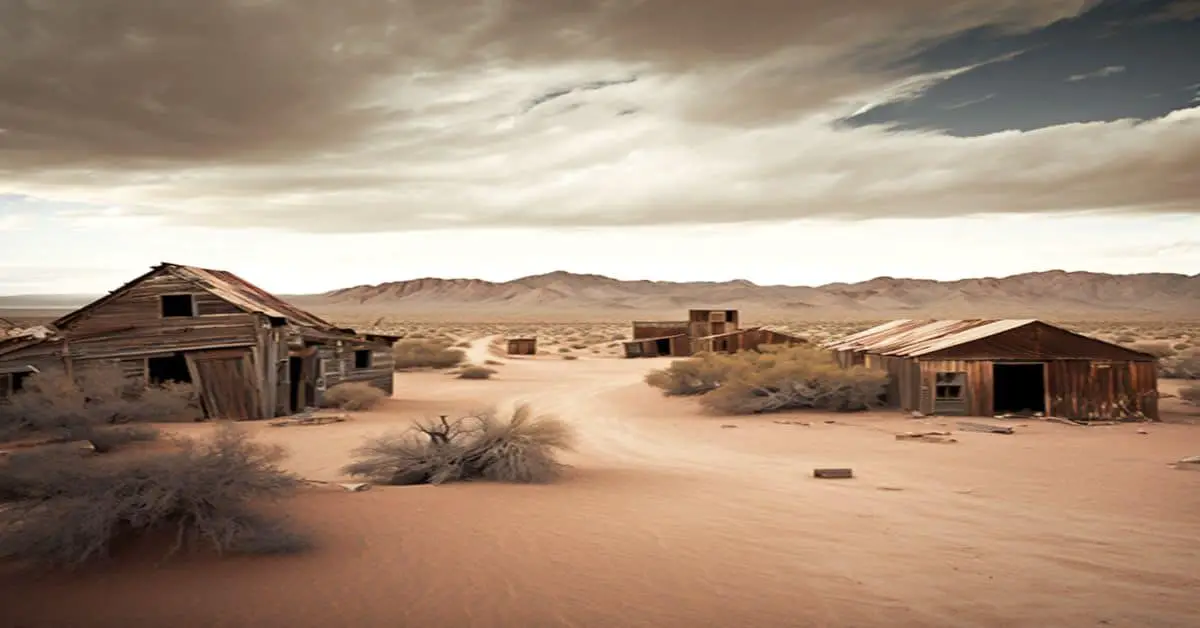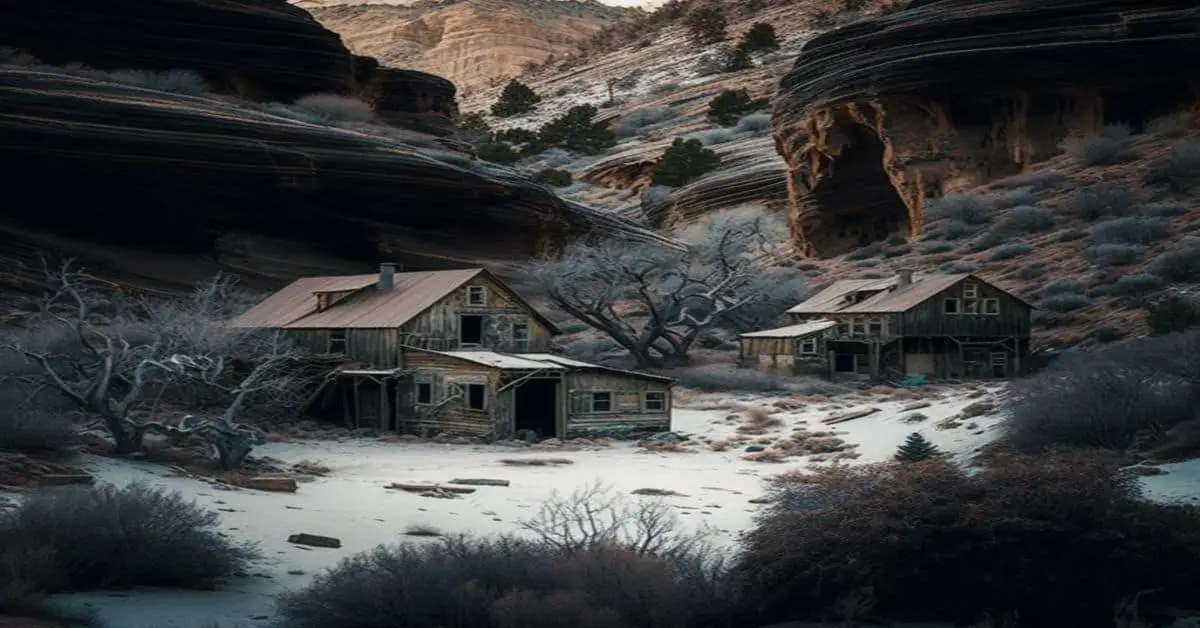Daggett, a once-thriving city in the Mojave Desert of California, is now a ghost town that is a testament to the region’s rich history. Founded in 1883 after the discovery of silver in nearby mines, Daggett was named after Lieutenant Governor of California, John Daggett. The town was planned to be the main station of the area, but its decline began when the railroad moved to Barstow.
Despite its dwindling population, Daggett remains a historical gem with its well-preserved buildings, graveyard, and remnants of its once-thriving city amenities. It provides a glimpse into the past, offering an opportunity to understand the challenges and triumphs of those who lived and worked in the area.
In this article, we will delve into the history of Daggett, exploring its founding, decline, and the remains that remain a testament to its past. Join us as we take a step back in time and discover the fascinating history of Daggett, a California ghost town.
Key Takeaways
- Daggett was founded in 1883 after the discovery of silver in nearby mines and named after Lieutenant Governor of California, John Daggett.
- Notable landmarks in Daggett included the Borax mining operations established in nearby Borate, and the narrow-gauge Borate and Daggett Railroad built in 1896.
- Daggett’s decline began when richer borax deposits were discovered in Death Valley in 1911, causing a decline in the town’s population, and eventually becoming a ghost town.
- Today, Daggett remains as a reminder of the mining boom in the Mojave Desert, attracting visitors interested in history and the stories of the American West.
Location and Founding
Daggett, a California ghost town located in the Mojave Desert, was founded in 1883 after silver was discovered in nearby mines. The town was named after Lieutenant Governor of California, John Daggett, and was initially planned to be the main station of the area. However, the railroad moved to Barstow, and the San Pedro, Los Angeles & Salt Lake Railroad built a line through Daggett instead.
Geographically, Daggett was significant as it was located in the Mojave Desert, a vast and arid region covering a large southeastern California area. Notable landmarks in Daggett included the Borax mining operations established in nearby Borate, and the narrow-gauge Borate and Daggett Railroad built in 1896.
Daggett also served as the terminal of the 20-mule team run from Death Valley for two years. Despite its promising beginnings, Daggett’s decline began after richer borax deposits were discovered in Death Valley in 1911.
Today, the town remains as a reminder of a bygone era, with only a few residents and buildings remaining.
History and Decline
The town of Daggett was established in 1883 after the discovery of silver in nearby mines. It was named after Lieutenant Governor of California, John Daggett, and was planned to be the main station of the area. However, the railroad moved to Barstow, and the San Pedro, Los Angeles & Salt Lake Railroad also built a line through Daggett.
The town became the terminal of the 20-mule team run from Death Valley for two years, and borax mining operations were established in nearby Borate. The narrow-gauge Borate and Daggett Railroad was built in 1896, but the town ultimately declined after richer borax deposits were found in Death Valley in 1911.
The decline of Daggett was caused by the discovery of richer borax deposits in Death Valley, which led to the closure of the borax mines in the area. This caused a decline in the town’s population, eventually becoming a ghost town.
Despite its decline, Daggett has cultural significance as a reminder of the mining boom in the Mojave Desert. The town’s remains, including buildings and a graveyard with graves dating back to the early 1900s, attract visitors who are interested in history and the stories of the American West. Daggett was also featured in the 1940 movie The Grapes of Wrath, further adding to its cultural significance.
Remains and Filming
Visitors can explore the remaining structures and cemetery, which date back to the early 1900s, to get a sense of the town’s history. The architecture of Daggett gives a glimpse into the past with its old-fashioned buildings and structures. The Daggett Pioneer Cemetery is a particularly interesting location, as it contains graves dating back to the early 1900s, showcasing the lives and deaths of the area’s early settlers.
In addition to its historical significance, Daggett has also been featured in a number of films. Film enthusiasts may recognize the town from its appearance in the 1940 movie The Grapes of Wrath. The movie, based on John Steinbeck’s novel of the same name, tells the story of the Joad family as they travel to California during the Great Depression.
The town has also been visited by many famous people, including the actor Humphrey Bogart, who reportedly stayed at the Daggett Hotel while filming a movie in the area.
Overall, Daggett offers a unique glimpse into the past and provides an interesting destination for history buffs and film enthusiasts.
Frequently Asked Questions
What was the population of Daggett at its peak?
Daggett population at its peak is not mentioned in the provided information. However, demographics analysis, historical significance exploration, and economic activities overview suggest that Daggett was a thriving town with several amenities in the 1890s. Currently, restoration and preservation initiatives aim to maintain the few remaining buildings and Daggett Pioneer Cemetery, which contains graves dating back to the early 1900s. Community impact assessment is not provided.
Were there any notable individuals or events associated with Daggett’s history?
Daggett’s history is devoid of notable individuals or events. No famous figures or historical events marked its rise and fall, only a silver discovery, borax mining, and a railroad that bypassed it.
What were the primary industries in Daggett besides borax mining?
In addition to borax mining, Daggett experienced railroad expansion in the late 19th century and was planned to be a main station in the area. Agricultural development also occurred, with three stores, two restaurants, and a Chinese eating place in the 1890s.
Are there any local legends or ghost stories associated with Daggett?
Local folklore suggests that Daggett is haunted, with reports of supernatural sightings and paranormal investigations in the area. No specific ghost stories are associated with the town, but the Pioneer Cemetery contains graves dating back to the early 1900s.
What efforts have been made to preserve or restore any of the remaining buildings or landmarks in Daggett?
Preservation efforts have been made to restore the Daggett Pioneer Cemetery. Historical significance is retained in the graveyard, containing graves dating back to the early 1900s, a testament to the town’s past.


